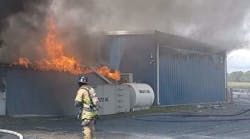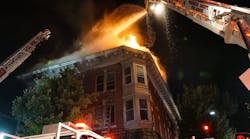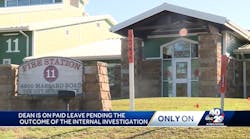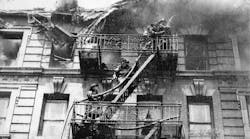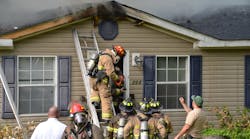Fire units from Sour Lake Fire, Pine Ridge Fire, Pinewood Fire, Bevil Oaks Fire, Nome Fire, China Fire, Lumberton Fire, SUNOCO Transfer/Storage Station and Milstead environmental battled an oil tank battery fire in the pouring rain.
Hardin County ESD #5 was dispatched at 1:40 p.m. for an oil tank that had been struck by lightning. Station 1 Chief Eugene Griffin (41), Station Two Chief Steve Derbyshire (61) and Station Two Firefghter Chad Pierce battled a torrential downpour responding to the emergency in the first due engine. Two inches of rain had fallen in less than 30 minutes leaving roads sloppy. Nearby ditches were swollen.
.Crews decided to stage approximately 300 yards from the fire to conduct a size-uo of the incident.
Unlike previous responses when a fire extinguisher could be used to extinguish this type of fire, the lightning had blown the roof off of one of the tanks and ignited the product inside. The fire quickly spread to a second of six tanks located inside the tank containment levee.
With the roof missing from one of the involved tanks combined with the fire and heavy rain, the primary concern was the potential for a boil over explosion. (A boil over explosion is when the water below the oil turns to steam and erupts like an oil volcano.)
Due to the minimum amount of class B foam on hand We added SUNOCO oil storage facility to our second and third alarm request, which included China Fire, Nome Fire, Bevil Oaks Fire, Lumberton Fire, Motiva Refinery, Entergy, Hardin County Haz-Mat team and Hardin County DEM.
The remote location of the incident added a water supply problem to the already overwhelming incident.
.,p> A strategic plan of attack was discussed with responder safety being the first priority. The decision was made to create a forward staging area 300 yards from the fire. This area would consist of an engine to draft from a portable dump tank and supply water line laid to the forward foam pumper.Personnel directly involved in suppression and support would be held at this location. The forward staging area was protected from contaminated runoff by containment booms that had been placed in the ditches as a precautionary measure. All other responding units were held one quarter of a mile away at an accountability check station. The staging area was managed by the crew of HCESD #5 EMS department. This was done to reduce congestion at the scene until the resources were assigned.
It was decided that suppression operations would not begin until an adequate supply of Class B foam was available, and engine resources were on scene that could provide for an extended water shuttle operation.
We made this decision based on past experiences where we used all of our foam and then ran out before the fire was extinguished, adding unwanted water to a half full oil tank and increasing the threat of a boil-over explosion.
The decision to wait turned out to be the correct one on this incident. SUNOCO arrived with 225 gallons of ARAFF Class B foam. 165 more gallons were on the way. We had four engines and one 3,500 gallon tender/tanker providing a water shuttle. A 300-foot supply line was laid from a drafting source to the forward foam pumper. Two one-and-three-quarter inch CAFS foam lines were advanced to cool the exposed tanks and extinguish the fire.
.Approximately 2,000 gallons of water and 70 gallons of foam were applied to the oil battery by firefighters from Hardin and Jefferson County to extinguish the blaze.
Once again, the incident command system provided for an organized approach to handle an incident with numerous responding agencies from multiple counties including both public and private responders. Safety was our number one concern. We may very well have been able to extinguish the fire with five gallons of foam and the initial engine, but we would have had to take a chance of exposing our responders to a potential disaster. I learned three things on this incident -- proper risk assessment is critical to keeping responders safe, training and pre-planning are critical and 4.5" of rain in one hour is just cause to buy a command vehicle.
See Related Training Articles
